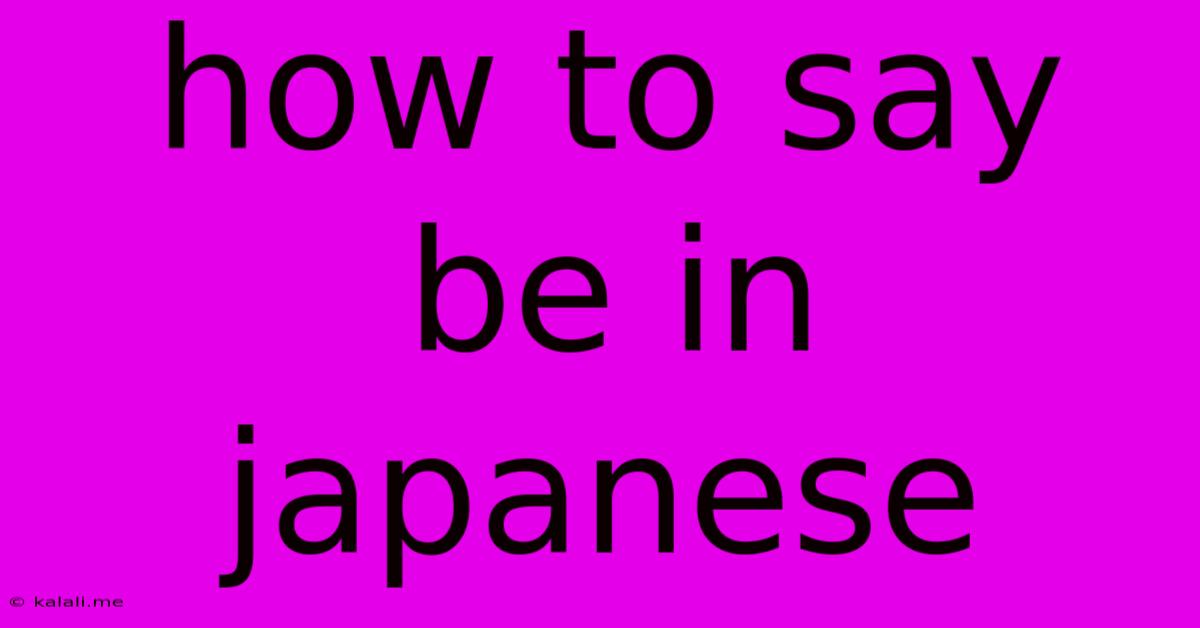How To Say Be In Japanese
Kalali
May 22, 2025 · 3 min read

Table of Contents
How to Say "Be" in Japanese: A Comprehensive Guide
The seemingly simple English verb "to be" presents a fascinating challenge in Japanese. Unlike English, which uses a single verb for various states of being, Japanese employs different verbs and grammatical structures depending on the context. This guide will delve into the nuances of expressing "to be" in Japanese, covering its various forms and appropriate usage. Mastering this will significantly improve your Japanese conversational skills and comprehension.
There isn't a single perfect equivalent of "to be" in Japanese. The best choice depends on whether you're describing existence, location, identity, or a state of being. Let's explore the key options:
1. いる (iru) - To Exist (for animate things)
This verb means "to be" or "to exist" and is used specifically for animate objects, like people and animals.
-
Example: 猫がいる。(Neko ga iru.) - There is a cat. (A cat exists.)
-
Conjugations: Like all Japanese verbs, いる has various conjugations depending on tense and politeness. Learning these is crucial for accurate usage.
2. ある (aru) - To Exist (for inanimate things)
Similar to いる, ある indicates existence but is used for inanimate objects and abstract concepts.
-
Example: テーブルがある。(Tēburu ga aru.) - There is a table. (A table exists.)
-
Conjugations: Similar to いる, ある has various conjugations to express different tenses and politeness levels.
3. です (desu) - To Be (for descriptions and identification)
This is the most common way to express "to be" in Japanese when describing something or identifying someone. It's a polite copula (linking verb) and usually follows a noun or adjective.
-
Example: これはペンです。(Kore wa pen desu.) - This is a pen.
-
Example: 私は学生です。(Watashi wa gakusei desu.) - I am a student.
-
Informal Version: In informal settings, you can use だ (da) instead of です.
4. だ (da) - Informal "To Be"
As mentioned above, だ is the informal equivalent of です. It's used in casual conversations with friends and family. Avoid using だ in formal situations.
5. Other Verbs Expressing States of Being
Many other verbs can be used to express different states of being, depending on the specific nuance:
-
いる (iru): can also imply being present at a location. For instance, "駅にいる" (eki ni iru) means "to be at the station."
-
ある (aru): can describe the presence of something in a place. For example, "ここに本がある" (koko ni hon ga aru) means "There is a book here."
-
になる (ninau): means "to become." For example, "医者になる" (isha ni naru) means "to become a doctor."
-
する (suru): means "to do" but can also express states of being. For example, "元気です" (genki desu), meaning "I'm healthy," uses the verb する implicitly within the adjective 元気 (genki - healthy).
Mastering "To Be" in Japanese
Understanding the different ways to express "to be" in Japanese requires practice and immersion. Pay attention to the context and the type of subject (animate or inanimate) when choosing the appropriate verb. Consistent study and exposure to the language will help you master these nuances and speak Japanese more fluently and naturally. Remember to learn the conjugations of いる, ある, and です to effectively communicate in various situations. This will greatly enhance your Japanese language skills and enable you to express yourself more accurately.
Latest Posts
Latest Posts
-
How Do You Make Grass Grow In Minecraft
May 22, 2025
-
In The Beach Or On The Beach
May 22, 2025
-
How To Remove A Stud Wall
May 22, 2025
-
Metal Gear Solid 5 Transportation Specialist
May 22, 2025
-
Can I Make Dauphinoise Potatoes In Advance
May 22, 2025
Related Post
Thank you for visiting our website which covers about How To Say Be In Japanese . We hope the information provided has been useful to you. Feel free to contact us if you have any questions or need further assistance. See you next time and don't miss to bookmark.